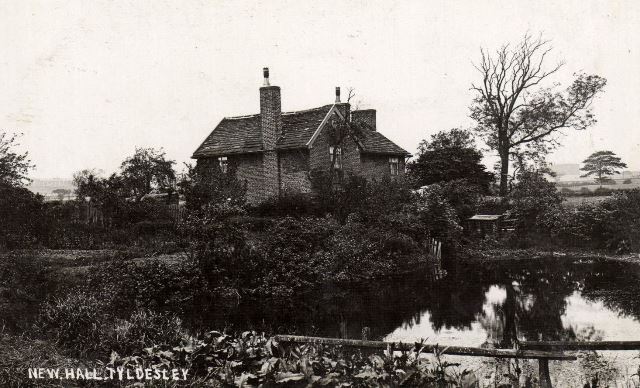New Hall moat, known by some locals as Dicky Beefs, is a scheduled monument in TyldesleyFormer industrial town in the Metropolitan Borough of Wigan, in Greater Manchester. Greater Manchester, England. The monument includes a moat and an island platform on which a modern house has been built. The island was the site of New Hall, a medieval farmhouse. The moat measures between 20 and 30 metres (66–98 ft) across, and is widest at the southwest corner where the water soaks away to join a stream. The moat was revetted on the south side, but the stonework is destroyed and is bridged on the same side by a modern stone bridge which replaced a timber structure. The rectangular island, measuring 60 metres by 40 metres (197–131 ft), encloses an area of 0.25 hectares (0.62 acres) and is 0.4 metres (1.3 ft) above the surrounding land. Archaeological evidence of the medieval buildings will be present on the island and the moat will retain other environmental evidence. A ruined post-medieval farmhouse occupied a third of the island in 1983. The modern buildings on the island are excluded from the scheduling, although the ground beneath them is part of the schedule.[1][2]
History
New Hall, in the Park of Tyldesley, close to DamhouseGrade II* listed building in Tyldesley but considered to be in Astley, Greater Manchester, England. It has served as a manor house, sanatorium, and, since restoration in 2000, houses offices, a clinic and tearooms. near the Astley/Tyldesley border, was in existence before 1422 when it belonged to Thomas Tyldesley. The hall and its 8.1 hectares (20 acres) of land was the subject of a feud between the Tyldesleys and the Hultons of Hulton Park which ended in 1422 when Roger Hulton gave up any title he had to Hugh Tyldesley.[3]
New Hall’s occupant in 1692 was Henry Marsh who was elected an overseer of the poor for Tyldesley lower side.[4] New Hall was described as a mansion house in 1716 when it was leased to a widow named Heyes. By 1742 Thomas Smith, a farmer, was tenant. In 1838 the property and its 23 Cheshire acresHistorical measure of area that was used in the 19th century. of land were owned by Lord Francis Egerton who leased it to John Lawton. The tenant from 1853 to 1872 was Richard Grundy and it acquired the local nickname, Dicky Beefs.[5]


